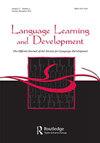The Influence of Exemplar Variability on Young Children’s Construal of Verb Meaning
IF 1.4
2区 文学
0 LANGUAGE & LINGUISTICS
引用次数: 2
Abstract
ABSTRACT Verbs serve as the architectural centerpiece of sentences, making verb learning pivotal for language acquisition. Verb learning requires both the formation of a verb-action mapping and the abstraction of relations between an object and its action. Two competing positions have been proposed to explain the process of verb learning: (a) seeing a highly variable range of exemplars allows children to detect and abstract the commonalities across actions—the action invariants; and (b) seeing a less variable range of exemplars enables children to focus on and extract the action invariants. Using manner—a major component of verb meaning in English—as a test case, this study addressed this debate by examining the influence of manner variability on the ability to fast-map new verbs and extend them to novel exemplars in 2-, 3-, and 4-year-old English-speaking children. Results contribute to this debate by showing that high manner variability hindered fast-mapping but facilitated extension to manner variations in the 2- and 3-year-olds. Thus, high exemplar variability may affect verb fast-mapping and extension differently. Furthermore, manner variability did not affect 4-year-olds’ (or adults’) fast-mapping or extension, suggesting that the influence of exemplar variability on verb learning attenuates with age. Finally, manner variability did not affect agent or object extension, revealing a component-specific effect of exemplar variability on verb extension.范例变异性对幼儿动词意义解释的影响
动词是句子结构的核心,因此动词学习对语言习得至关重要。动词学习既需要形成动词-动作映射,也需要抽象对象与其动作之间的关系。人们提出了两种相互竞争的观点来解释动词学习的过程:(a)看到高度可变的范例范围使儿童能够发现和抽象出动作之间的共性——动作不变量;(b)看到较少变化的范例范围使儿童能够关注并提取动作不变量。本研究以英语中动词意义的主要组成部分——举止为例,考察了举止变化对2岁、3岁和4岁的英语儿童快速映射新动词并将其扩展到新范例的能力的影响,从而解决了这一争论。结果表明,在2岁和3岁的儿童中,高度的行为差异阻碍了快速映射,但促进了对行为差异的扩展,从而促进了这一争论。因此,高例证可变性可能对动词的快速映射和扩展产生不同的影响。此外,方式变异性不影响4岁儿童(或成人)的快速映射或扩展,这表明范例变异性对动词学习的影响随着年龄的增长而减弱。最后,方式的可变性不影响主体或客体的扩展,这揭示了样例可变性对动词扩展的成分特异性影响。
本文章由计算机程序翻译,如有差异,请以英文原文为准。
求助全文
约1分钟内获得全文
求助全文

 求助内容:
求助内容: 应助结果提醒方式:
应助结果提醒方式:


